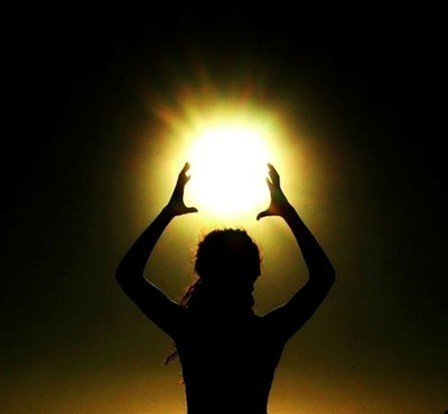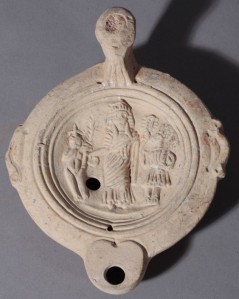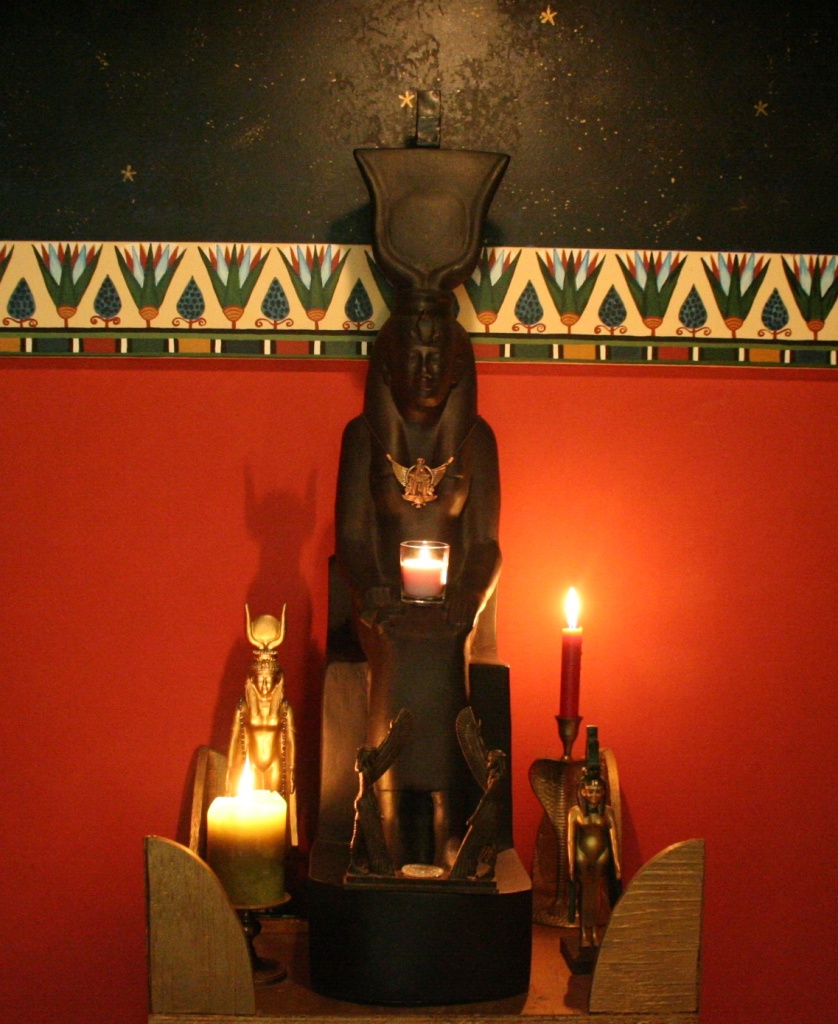We’re not quite there yet, but I thought you might like to have this small rite early in case you’d like to find a special outdoor place to celebrate the coming solstice.
In Egypt, about 3000 BCE, at the latitude of ancient Memphis, the summer solstice coincided with the heliacal rising of Sirius, the star of Isis, the beginning of the all-important inundation, and the coming of the new year. It was a time of joy as people anticipated the coming harvest and other blessings from the Divine Ones.
In this rite, we celebrate with gratitude the fullness of summer in the dawning light of our closest star, the sun. Yet we also know that the ba of Isis—in Her holy star Sirius—is also present with us, though still unseen by most of us in the northern hemisphere.
And, of course, Isis is a Sun Goddess, too.
Stuff You’ll Need
For this rite, you’ll need Nile water and a vessel, a flowery incense and something to safely burn it in, your sistrum, and a ripe avocado or sweet, juicy fruit like a peach, and something to cut it with. You’ll be eating the fruit in offering communion with Her, so make it something you like.
Your Temple Space
Ideally, this is an outdoor space where you can see the sun rise on summer solstice. Make sure you arrive before sunrise. If not possible, you can also do this indoors, visualizing the sunrise.
Arising
Rattle your sistrum softly at your heart. As you see the sun rise, stand and open your arms like the wings of Isis.
Ritualist: (Vibrating softly) ISET-RE, ISET-SOPDET! (Speaking softly) I welcome You with open heart into Your abode (moving your hands to cross upon your heart).
Purifying the Heart
Pour the Nile water into the vessel. Sprinkle water upon your own body, paying special attention to your heart.
Ritualist: Purify, purify, purify, purify! I am purified by the Mother of Rivers, the Lady of the Living Waters. Into Her care I release al pain, all anger, all frustration, all regret—all the sorrows of my heart. (Breathe deeply and repeat until you feel that it is so.)
The temple of my heart is made new, purified and opened unto Isis, the Lady of Abundance.
Awakening the Heart
Take up the sistrum again, light the incense. Rattling the sistrum softly at your heart (so much the better if you can feel the vibrations of the sistrum), say,
Ritualist: In the name of Isis-Re, in the name of Isis-Sothis, my heart awakens. (Breathe deeply and repeat until you feel that it is so.)
Be seated comfortably. Now listen and hear. Listen to the dawn and find the heartbeat of the Great Goddess Isis. Her noble heart beats all around you. In the awakening song of birds. In the wind moving through grass and trees. In the waters. In the deep earth.
Find the heartbeat of Isis.
Now, touch a pulse point on your own body and find your heartbeat.
Attune your heartbeat to Hers, slowing or speeding up as needed. (Just do the best you can; it doesn’t have to be perfect.)
Ritualist: (Speaking softly to yourself and to the Goddess) Iset Ib, my heart’s desire. Her heart. My heart.
I am aware in my heart. I am in power in my heart. I am aware and in power in my heart, which is the heart given to me by my mother (stating the name of your human mother)—and by my Great Mother Isis.
Iset Ib, my heart’s desire. Her heart. My heart.
I am intelligent in my heart. I am compassionate in my heart. I am intelligent and compassionate in my heart, which is the heart which drums in rhythm with the heart of Great Isis.
Iset Ib, my heart’s desire. Her heart. My heart.
I am alive in my heart. I am full in my heart. I am alive and full in my heart, the center of all Being, the beginning of all Becoming. I am alive and full in my heart, and my heart knows all the joys and pleasures of my life.
In the fullness of my Being, I am Becoming joyful. Isis arises—all is well. Isis comes—peace returns. I am sitting in the Throne of Abundance. Once again, I attune my human heart to Her Divine heart (pausing to do this).
Now speak aloud at least ten things for which you are grateful. If you can name more than that, do so. Let yourself feel joy, satisfaction, pleasure, or pleasant surprise as you name each thing. Take time to re-attune your heart to the Goddess’ heart between each thanksgiving. When you are finished, continue:
Ritualist: Iset Ib, my heart’s desire. Her heart. My heart. I am aware in my heart and I am grateful in my heart. You have blessed me, Isis, and I bless You. Amma, Iset. Grant that it ever be so.
Communion of the Heart of Isis
Take out the avocado (or other fruit) and look upon it.
Ritualist: This fruit is the fruit of the holy persea tree, sacred unto Isis. It is the fruit of the tree from between whose branches rises the Soul of Isis—Sothis—and the Face of Isis—the Sun. The wise say that the sacred persea bears the Heart of Isis (elevating fruit), therefore when I hold this persea fruit in my hands, I hold the Heart of the Goddess. Rich and sweet, the persea fruit is indeed the Heart of the Beautiful One, the Heart of Abundant Summer.
Cut the fruit into five pieces and lay them upon the altar like the five-rayed Star of Isis.
Ritualist: O Isis-Re, O Isis-Sothis, You shared with me Your sacred heart (eating one piece of fruit). Spirit is joined to spirit (eating another piece of fruit). Mind is joined to mind (eating another piece of fruit). Soul is joined to soul (eating another piece of fruit). Body is joined to body (eating the last piece of fruit). Heart joined to heart (crossing your hands over your heart).
Closing
Take up the sistrum and, beginning at your heart, rattle it in the four directions, above you and below you.
Ritualist: O Isis, You have filled my heart. You are indeed the Lady of Abundance.
Take up the vessel of water. Holding it at your heart, sprinkle water in the four directions, above you and below you.
Ritualist: O Isis, I ask that my heart remain open to Your heart, this day and every day. Amma, Iset. Grant that it be so.
Face east and the rising sun and the hidden star. Open your arms like the wings of Isis, then close them over your heart. Remove all traces of your presence, then depart in peace.
NOTE: This is a shortened version of the summer solstice rite from Isis Magic. For the more complete rite, see pages 344-351 in the second edition.
















